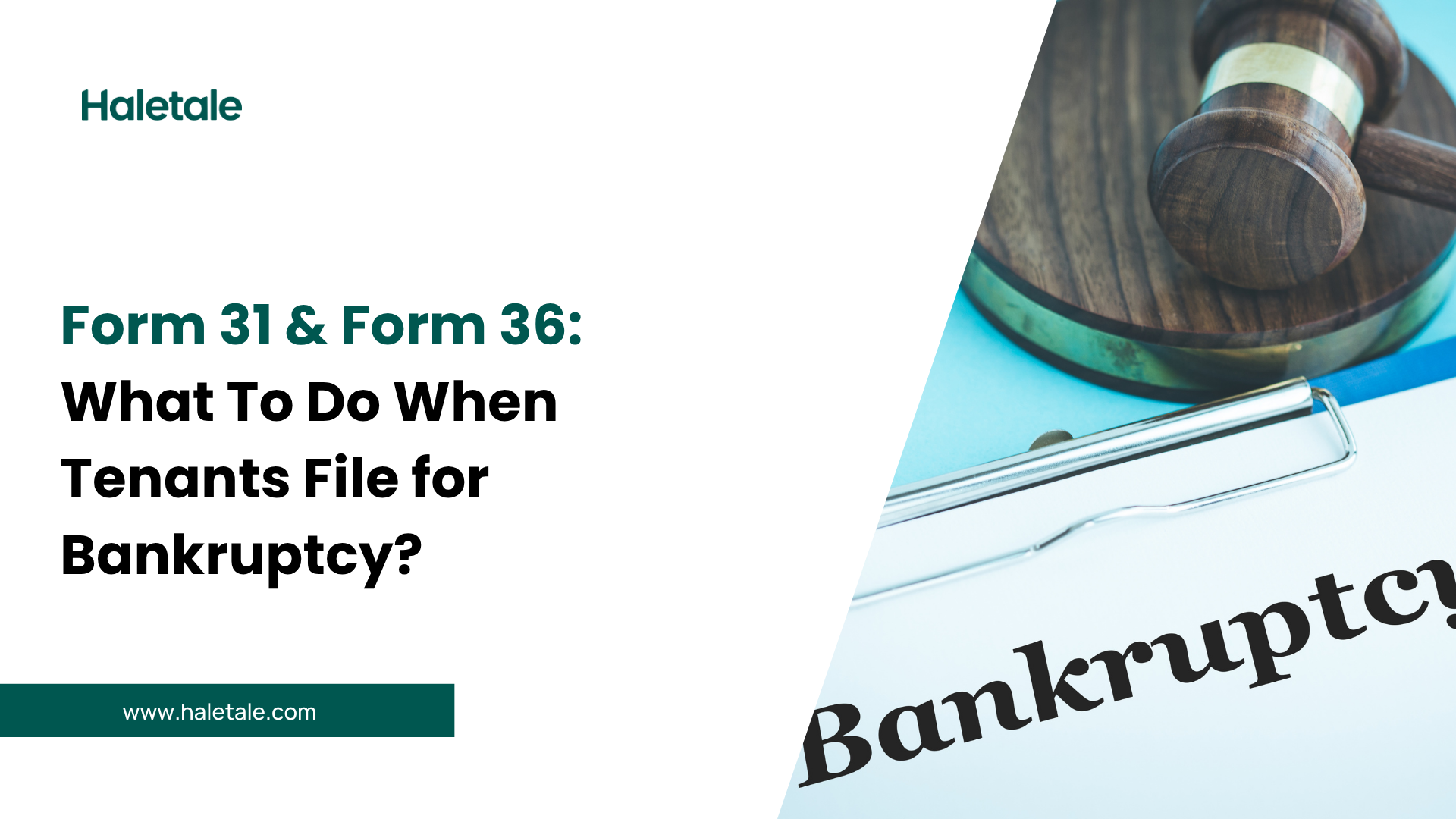What Happens When Your Tenant Files for Bankruptcy? Navigating Form 31 and Form 36 for Canadian Property Managers
When a tenant files for bankruptcy in Canada, property managers and landlords face a complex web of legal requirements and financial uncertainties. Understanding how to properly file Form 31 (Proof of Claim) and utilize Form 36 (Proxy) can mean the difference between recovering rental arrears and absorbing significant losses. This comprehensive guide breaks down everything Canadian property managers need to know about navigating tenant bankruptcy scenarios using these critical forms.
Understanding the Bankruptcy Landscape for Canadian Landlords
Tenant bankruptcy creates an immediate operational challenge for property managers using property management software to track rent collection and manage their portfolios. When a tenant assigns into bankruptcy, they transfer all their assets to a Licensed Insolvency Trustee (LIT), effectively freezing most collection efforts and legal proceedings through what’s called an “automatic stay.”
For property managers handling 50+ properties, a single bankruptcy can disrupt cash flow projections and complicate financial reporting. The bankruptcy process fundamentally changes the landlord-tenant relationship, transforming your tenant’s obligations into claims against their estate that must be properly documented and submitted.
Recent changes to the Bankruptcy and Insolvency Act have updated Form 31 requirements, with all estates filed on or after September 16, 2024, required to use the new version. This timing makes understanding these forms particularly crucial for Canadian property managers navigating current tenant challenges.
Form 31: Your Primary Tool for Rental Debt Recovery
What Is Form 31 and Why It Matters
Form 31, officially known as the Proof of Claim, serves as your formal declaration of money owed by the bankrupt tenant. This document isn’t just paperwork—it’s your ticket to potentially recovering unpaid rent through the bankruptcy process. Without properly filing Form 31, you forfeit your right to any distribution from the tenant’s bankruptcy estate.
The form requires landlords to certify their identity and specify exact amounts owed, including rent arrears up to the bankruptcy date. For commercial property managers and residential landlords alike, accuracy in completing this form is paramount, as false claims can result in fines up to $1,000 or imprisonment.
Property managers using tenant screening and lease management software should maintain detailed records to support their Form 31 claims. Digital lease agreements and automated rent collection systems provide crucial documentation when substantiating bankruptcy claims.
Breaking Down Your Landlord Priority Status
Canadian bankruptcy law recognizes landlords as preferred creditors for specific amounts:
- Residential Tenancies: Up to three months of rent arrears before bankruptcy
- Commercial Tenancies: Three months pre-bankruptcy arrears plus three months accelerated rent (if specified in lease)
- Additional Claims: Any amounts beyond these limits become unsecured claims
This preferred creditor status positions landlords ahead of general unsecured creditors but behind secured creditors and trust claimants. Understanding this hierarchy helps property managers set realistic expectations for recovery through proper financial management.
Step-by-Step Guide to Completing Form 31
- Gather Essential Documentation Before starting Form 31, compile:
- Original signed lease agreement
- Detailed rent ledger showing payment history
- Any maintenance requests or damage claims
- Communication records regarding unpaid rent
- Banking records of received payments
- Calculate Accurate Amounts Using your property management accounting features, determine:
- Total rent arrears to bankruptcy date
- Any applicable late fees or interest (if lease permits)
- Outstanding utility charges or other tenant obligations
- Security deposit amounts held (these may need to be remitted)
- Complete the Certification Form 31 requires you to certify:
- Your status as creditor/landlord
- Knowledge of circumstances surrounding the debt
- Exact amount owed after deducting counterclaims
- Details of recent payments or transfers
- Attach Supporting Schedule A Your Statement of Account must include:
- Monthly breakdown of rent charges
- Payments received and dates
- Running balance calculations
- References to supporting documents
- Specify Priority Claims Clearly separate:
- Preferred claims (three months’ rent)
- Unsecured claims (remaining arrears)
- Secured claims (if applicable)
Property managers leveraging QuickBooks integration can export detailed financial reports to support their Form 31 submissions, ensuring accuracy and completeness.
Form 36: Appointing Your Representative Through Proxy
Understanding the Proxy Function
Form 36 allows creditors to appoint a proxy holder to represent them at creditors’ meetings. For busy property managers overseeing multiple properties, this form enables participation in bankruptcy proceedings without personal attendance.
The proxy holder gains authority to:
- Vote on behalf of the creditor
- Participate in creditors’ meetings
- Make decisions regarding the bankruptcy administration
- Object to proposals or arrangements
However, proxy holders cannot receive dividend payments—these must go directly to the creditor. This limitation protects landlords while allowing flexible representation.
When and How to Use Form 36
Strategic Proxy Appointments Consider appointing a proxy when:
- Managing properties across different provinces
- Multiple tenants file bankruptcy simultaneously
- Legal counsel represents your interests
- Joining creditor groups for collective action
Completing Form 36 The form requires:
- Your name and address as creditor
- Proxy holder’s complete information
- Specification of powers granted
- Your signature and date
- Electronic submission requirements if applicable
For professional property management companies, having standardized proxy arrangements with legal representatives streamlines the bankruptcy response process.
How Forms 31 and 36 Work Together in Practice
Coordinated Strategy for Maximum Recovery
Successful bankruptcy claims require coordinating Form 31 submissions with strategic proxy appointments through Form 36. Here’s how they complement each other:
Initial Filing Phase
- Receive bankruptcy notice from trustee
- Immediately calculate arrears using your rental property management software
- File Form 31 within specified deadlines
- Assess need for proxy representation
Creditors’ Meeting Preparation
- Review trustee’s preliminary report
- Coordinate with other landlord creditors
- Appoint proxy via Form 36 if needed
- Prepare voting strategy on proposals
Active Participation
- Proxy attends meetings on your behalf
- Votes according to your instructions
- Objects to unfavorable proposals
- Protects preferred creditor status
This integrated approach maximizes recovery potential while minimizing time investment for busy property managers.
Common Scenarios and Solutions
Scenario 1: Tenant Bankruptcy After N4 Notice When tenants declare bankruptcy after receiving a Notice to End Tenancy for Non-Payment (N4), landlords must:
- Amend the N4 to include the trustee as party
- Serve amended notice to trustee’s business address
- File Form 31 for arrears to bankruptcy date
- Continue eviction proceedings if judgment exists
Scenario 2: Commercial Tenant with Letter of Credit Commercial landlords with security like letters of credit should:
- Draw on LOC immediately upon default
- File Form 31 for amounts exceeding security
- Coordinate with bank regarding LOC terms
- Document all draws for bankruptcy proceedings
Scenario 3: Multiple Unit Portfolio Impact Property managers with extensive portfolios facing multiple bankruptcies should:
- Implement systematic Form 31 filing procedures
- Consider appointing single proxy for all cases
- Use automated accounting features to track claims
- Coordinate with property management software for reporting
Best Practices for Canadian Property Managers
Documentation and Record-Keeping
Maintaining comprehensive records proves essential when filing bankruptcy claims. Your property management platform should track:
- Payment History: Every transaction with timestamps
- Communication Logs: All tenant correspondence
- Lease Modifications: Amendments and addendums
- Maintenance Records: Repair requests and completions
- Legal Notices: All served documents with proof
Digital documentation through tenant portal software creates an audit trail supporting Form 31 claims and protecting against challenges.
Proactive Measures to Minimize Bankruptcy Impact
Enhanced Tenant Screening Implement robust tenant screening procedures including:
- Credit report analysis
- Employment verification
- Previous landlord references
- Income-to-rent ratio assessment
- Bankruptcy history checks
Early Warning Systems Monitor for bankruptcy indicators:
- Repeated late payments
- Partial rent payments
- Avoiding communication
- Business closure signs (commercial)
- Requests for payment plans
Security Optimization Structure security to survive bankruptcy:
- Maximize allowable deposits
- Require guarantors when appropriate
- Consider rent insurance programs
- Implement automated rent collection
Legal Compliance and Updates
The Bankruptcy and Insolvency Act undergoes periodic updates affecting Forms 31 and 36. Property managers must:
- Stay Current: Monitor Directive updates from the Office of the Superintendent of Bankruptcy
- Use Correct Forms: Ensure using post-September 2024 versions for new filings
- Understand Provincial Variations: Know how provincial tenancy laws interact with federal bankruptcy law
- Maintain Compliance: Follow all disclosure and documentation requirements
Integration with legal compliance features in modern property management software helps ensure adherence to evolving requirements.
Technology Integration for Bankruptcy Management
Leveraging Property Management Software
Modern property management platforms streamline bankruptcy response through:
Automated Calculations
- Instant arrears computation
- Interest and fee tracking
- Preferred claim segregation
- Supporting schedule generation
Document Management
- Centralized lease storage
- Communication archives
- Legal notice tracking
- Form preparation assistance
Financial Reporting
- Real-time account status
- Historical payment analysis
- Bankruptcy impact assessment
- Recovery tracking
Integration Benefits QuickBooks integration enables:
- Detailed financial exports for Form 31
- Accurate historical reporting
- Professional documentation
- Simplified claim substantiation
Future-Proofing Your Bankruptcy Response
As technology evolves, property managers should prepare for:
- Digital Form Submission: Electronic filing becoming standard
- AI-Powered Risk Assessment: Predictive bankruptcy indicators
- Automated Claim Tracking: Real-time bankruptcy estate monitoring
- Integrated Legal Services: Seamless proxy appointment systems
Investing in comprehensive property management software positions landlords to handle bankruptcy scenarios efficiently while maintaining portfolio performance.
Conclusion: Protecting Your Rental Income Through Proper Documentation
Understanding and properly utilizing Form 31 and Form 36 represents a critical competency for Canadian property managers facing tenant bankruptcies. These forms work synergistically—Form 31 establishes your claim while Form 36 ensures your voice in proceedings without requiring personal attendance.
Success in bankruptcy scenarios depends on preparation, accurate documentation, and timely response. Property managers who maintain detailed records through comprehensive management software, understand their creditor rights, and respond promptly to bankruptcy notices position themselves for maximum recovery.
Remember that while bankruptcy creates challenges, proper use of these forms combined with proactive management practices can significantly minimize losses. As the rental landscape continues evolving, staying informed about bankruptcy procedures and maintaining robust documentation systems remains essential for protecting your rental income and portfolio value.
For property managers seeking to strengthen their bankruptcy preparedness, implementing professional property management solutions with integrated financial tracking, automated documentation, and compliance features provides the foundation for effective Form 31 and Form 36 utilization.









